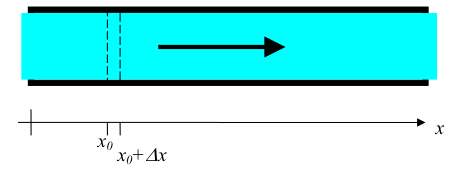
Problems for
Intermediate Methods in Theoretical Physics
Edward F. Redish
 |
Problems for |
Consider a fluid (of density ρ) completely filling a straight pipe (with circular cross section and radius r) and flowing through at a constant speed v. We will assume there is a drag force between the fluid and the wall that tries to slow the fluid down. A reasonable model for this force is that it is proportional to the area of contact between the fluid and the wall and to the speed of the fluid relative to the wall: Drag force / unit area of wall-fluid contact = - cv.

(b) For this small bit of fluid moving with a velocity v, what is the magnitude and direction of the drag force acting on it?
(c) In order to maintain the fluid moving at a constant speed, the pressure must change along the pipe. Explain why.
(d) Suppose the pressure along the pipe varies as a function of x by some (unknown) function, p(x). Find an expression for the change in pressure
in terms of the symbols we have specified.
(e) Show that a linear function satisfies that change equation you obtained in (c). If you can find an appropriate lienar function, do so. If you can't, explain why not.
(f) For a pipe of length L, use your results from (d) to show that the flow of matter through the pipe (I) is related to the pressure drop across the pipe [Δp= p(L) - p(0)] by an equation of the form Δp = IR where R is the resistance of the pipe (not the radius). Discuss the dependence of R on the parameters of the problem and whether your result for the various dependences of R is plausible.
| University of Maryland | Physics Department | Physics 374 Home |
|---|---|---|
 |
 |
 |
Last revision 29. November, 2004.